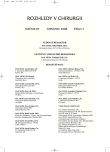-
Medical journals
- Career
Pseudoaneurysm of the Hepatic Artery Presenting with Hemobilia – a Complication of Laparoscopic Cholecystectomy
Authors: K. Schwarzmannová 1; T. Poch 1; J. Šimša 1; T. Vidim 1; P. Chudomel 1; P. Volšanský 2; S. Kašík 3; M. Chochola 4
Authors‘ workplace: Chirurgické oddělení Oblastní nemocnice Kolín, a. s., primář: doc. MUDr. J. Šimša, Ph. D. 1; Endoskopické centrum Oblastní nemocnice Kolín, a. s., primář: MUDr. P. Volšanský 2; Radiodiagnostické oddělení Oblastní nemocnice Kolín, a. s., primář: MUDr. S. Kašík 3; Angiocentrum Kolín, a. s., vedoucí lékař: MUDr. P. Kudrna 4
Published in: Rozhl. Chir., 2008, roč. 87, č. 7, s. 360-363.
Category: Monothematic special - Original
Overview
Introduction:
Hemobilia, defined as a bleeding into the bile duct, is a rare disease. One of its infrequent causes is a hepatic artery pseudoaneurysm, usually developed after arterial iatrogenic leasion.Material and methods:
A case review, presenting right hepatic artery pseudoaneurysm with a biliovascular fistula as a consequence of hepatic artery and bile duct injuries during „uncomplicated“ laparoscopic cholecystectomy.Discussion:
Bile duct injury is one of the most serious complication after laparoscopic cholecystectomy. Hepatic artery may be injured simultaneously, resulting in the pseudoaneurysm and/or biliovascular fistula, presenting with hemobilia. Time interval from the injury to symptoms widely varies from few hours to weeks or even several months.Conclusion:
Melena or hematemesis after recent laparoscopic cholecystectomy should be always suspicious from hepatic artery and/or bile duct injuries, manifesting with hemobilia.Key words:
laparoscopic cholecystectomy – complication – pseudoaneurysm – biliovascular fistula – hemobilia – embolisation – stent
Sources
1. Bělina, F. Chirurgická léčba akutního krvácení do trávicí trubice. Bulletin HPB chirurgie, 2006, 14(1–2): 22–24.
2. Charvát, D., Leffler, J., Hoch, J. Chirurgická léčba krvácení z gastroduodenálního vředu. Rozhl. Chir, 2007, 86(4): 166–169.
3. Šiller, J., Havlíček, K., Turnovský, P., et al. Hemobilie, vzácná příčina krvácení do GIT. Rozhl. Chir., 2008, 87(2): 89–91.
4. Šváb, J., Pešková, M., Lukáš, M., et al. Poranění žlučovodů a papily. Bulletin HPB chirurgie, 2003, 11(2): 72–76.
5. Pafko, P., Stolz, A., Lischke, R. Excize extrahepatálních žlučových cest při laparoskopické cholecystektomii. Rozhl. Chir., 2001, 80(6): 297–298.
6. Iannelli, A., Karimdjee, B. S., Fabiani, P. et al. Hemobilia due to pseudoaneurysm of the right hepatic artery following laparoscopic cholecystectomy. Gastroenterol. Clin. Biol., 2003, 27(3): 341–343.
7. Srinivasaiah, N., Bhojak, M., Jackson, R., et al. Vascular emergencies in cholelithiasis and cholecystectomy: our experiences with two cases and literature review. Hepatobiliary Pancreat. Dis. Int., 2008, 7(2): 217–220.
8. Kramann, B., Daoyu, H., Kubale, R., et al. Experiences with the endovascular embolization therapy of aneurysms of the splanchnic arteries – report on 13 cases. Rofo, 1995, 163 (5): 417–423.
9. DeFreitas, D., Phade, S., Stoner, M., et al. Endovascular stent exclusion of a hepatic artery pseudoaneurysm. Vasc. Endovascular. Surg, 2007, 41(2): 161–164.
Labels
Surgery Orthopaedics Trauma surgery
Article was published inPerspectives in Surgery

2008 Issue 7-
All articles in this issue
- Experience with Radiofrequency Termoablation of Brain Tumors
- Ischemic Affection of the Spinal Cord as a Result of the Blunt Thoracic Trauma – A Case Report
- Re-expansion Pulmonary Edema as a Complication of a Spontaneous Pneumothorax Drainage – a Case Review
- A Female Patient with Heart Fibrosarcoma. A Case Review
- Stents – Paliative and Curative Management of Esophageal Conditions. Seven-Year Surgical Experience
- Pseudoaneurysm of the Hepatic Artery Presenting with Hemobilia – a Complication of Laparoscopic Cholecystectomy
- Rare Cases of Extensive Retroperitoneal Liposarcomas
- Post-Gastrectomy Reconstruction
- Massive Hemothorax following Canylation of the Subcalvian Vein – a Case Review
- Pectoralis Maior Tendon Rupture and Anabolic Steroids in Anamnesis – a Case Review
- Hybrid Procedures in the Treatment of Pseudoaneurysms of the Aortic Arch – Case Report
- Perspectives in Surgery
- Journal archive
- Current issue
- Online only
- About the journal
Most read in this issue- Pectoralis Maior Tendon Rupture and Anabolic Steroids in Anamnesis – a Case Review
- Rare Cases of Extensive Retroperitoneal Liposarcomas
- Re-expansion Pulmonary Edema as a Complication of a Spontaneous Pneumothorax Drainage – a Case Review
- Stents – Paliative and Curative Management of Esophageal Conditions. Seven-Year Surgical Experience
Login#ADS_BOTTOM_SCRIPTS#Forgotten passwordEnter the email address that you registered with. We will send you instructions on how to set a new password.
- Career

